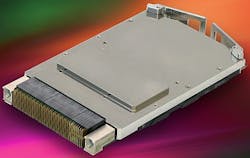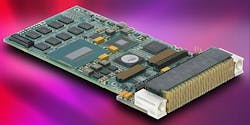HPEC products on the bleeding edge
Aerospace and defense technology providers introduce high-performance embedded computing (HPEC) products.
Kontron launches COBALT system with I/O options to meet edge application requirements
Kontron introduces the next-generation Kontron high-performance embedded computer COBALT (Computer Brick Alternative) rugged, small-form-factor system that takes advantage of the company’s hardened COM Express Computer-on-Modules (COMs) and the latest Intel x86 architecture.
The Kontron COBALT provides tightly-coupled mezzanine features, a ruggedized compact carrier board, and system interface board (SIB) that give customers increased input/output (I/O) options to meet specific edge application requirements. The modular platform matches ongoing development demands in applications such as military and commercial avionics related to both manned and unmanned aircraft where small, high-compute platforms are required, officials say.
Meeting severe environment operational demands, Kontron designed the IP67 chassis to operate reliably in a multitude of conditions including extreme temperatures, shock, vibration, and electromagnetic interference (EMI). Powering the Kontron COBALT base system is a 3rd-generation Intel dual core-based COM Express Type 6 module featuring ECC, rapid shutdown design, and extended temperature screening with the option of removable or fixed SSDs and/or fixed mSATA storage. Windows, Linux and VxWorks operating system and software support packages are also available.
The carrier board design maximizes the system’s capabilities while minimizing its overall size and meeting higher temperature and shock and vibration conditions. The Kontron COBALT is a fanless, fully enclosed system that provides thermal management in a small 5.5 x 8.5 x 3.5-inch (139.7 x 215.89 x 88.89-mm) form factor weighing less than 5.5 pounds (2.5 kg). Kontron will release application-specific profiles of its next-generation COBALT platform through 2014 and can support custom-configured solutions.
Aitech offers 3U VPX GPGPU embedded computing board for sensor processing, C4ISR
Aitech Defense Systems Inc. in Chatsworth, Calif., presents its C530 3U VPX general-purpose graphics processing unit (GPGPU) embedded computing computer for advanced sensor processing and applications in command, control, communications, computers, intelligence, surveillance, and reconnaissance (C4ISR).
The C530 carries industry-standard MXM modules with the ability to upgrade to newer modules as they become available, Aitech officials say. The MXM modules enable one module to function across several platforms, providing expanded graphics and teraflop processing options for each system.
The C530 GPGPU board comes with one of two MXM modules: the NVIDIA GeForce GTX 675MX at 600 MHz; 4 gigabytes of GDDR5 memory at 1800 MHz; or the AMD Radeon HD 7970M at 850 MHz; 2 gigabytes of GDDR5 memory at 1200 MHz. The multi-format video output channels included as standard on the C530 enable the board to perform rugged signal processing and high-resolution graphics.
The C530 connects to Intel-based VPX single-board computers via a high-speed PCI Express Gen 2.0 link using to 16 lanes over the VPX backplane. "GPGPUs are for performing parallel processing and high-bandwidth image processing, serving as dedicated math co-processors for advanced digital signal processing and embedded computing subsystems," explains Doug Patterson, vice president of business development and marketing for Aitech.
The C530 GPGPU processes sensor data and situational awareness information in defense and aerospace applications, and comes in commercial and rugged air-cooled as well as conduction-cooled configurations for severe and harsh environments per VITA 46. Conduction-cooled versions comply with VPX-REDI (VITA 48.2).
NVIDIA launches GPU-accelerated platform for geospatial intelligence analysts
NVIDIA has launched a GPU (graphics processing unit)-accelerated platform to help geospatial intelligence (GeoInt) security analysts to find actionable insights quickly and accurately from vast quantities of raw data, images, and video: the NVIDIA GeoInt Accelerator.
The NVIDIA GeoInt Accelerator provides defense and homeland security analysts with tools that enable faster processing of high-resolution satellite imagery, facial recognition in surveillance video, combat mission planning using geographic information system (GIS) data, and object recognition in video collected by drones.
"Today's intelligence analyst needs information based on imagery, video, signals intelligence, human intelligence, and other sources, in a geospatial context and at rate,” recognizes Nick Buck, CEO of Buck Consulting Group and former IT executive with the NRO Ground Directorate. “The NVIDIA GeoInt Accelerator provides developers the opportunity to unleash the power of GPU computing to combine the variety and volume of data sources at the speed needed for mission support, enabling new levels of performance with minimal investment."
The complete solution includes: an NVIDIA Tesla GPU-accelerated hardware system, software applications for geospatial intelligence analysis, and advanced application development libraries.
NVIDIA GPU accelerators are used in aerospace and defense for imaging, video, and signal processing by customers such as Army Research Labs, BAE Systems, Boeing, SAIC, NATO, NAVAIR, Northrop Grumman, Onera, Raytheon, and Thales Group, officials say.
Multiple deployment solutions are available from embedded GPU accelerators from GE Intelligent Platforms and Curtis-Wright, and workstations and server cluster solutions from major OEMs, including Dell, HP, and IBM.
RFEL delivers real-time image processing for enhanced surveillance
RFEL Ltd. in Newport, England, debuts the HALO low-power real-time video processing system for image-based surveillance applications in aerospace and defense.
HALO provides adaptive contrast enhancement to combat poor imagery in challenging lighting conditions., as well as delivers high-quality, high frame rate, high-definition video for human or machine interpretation challenging of visual environments.
HALO is not restricted by ITAR regulations, and is for fixed and mobile installations, including covert CCTV monitoring and surveillance, and unmanned aerial vehicles (UAVs), company officials say.
The video processing capabilities provided by HALO are intelligent fusion of multi-modal imagery, such as from a visible and IR sensor; mage stabilization, even when the platform is subject to severe vibration, and when imagery is sparse in features or of low contrast enhancement to maintain high performance operation in marginal lighting conditions--visible and IR; noise reduction for optimizing operation in low ambient light and for ensuring robust image fusion; and digital zoom, lens distortion correction, image overlay and support for compression standards.
HALO uses field programmable gate array (FPGA) for processing bandwidths at low power consumption from a power supply of between 4.7 to 27 volts DC. The HALO processor board comes in a rugged enclosure, and the entire system measures 105 by 105 by 80 millimeters and weighs less than 400 grams.
HALO offers a range of physical interfaces and supports all major video standards from analogue video (e.g. PAL/NTSC/S-Video) through to digital standards such as Channel Link standards and GigE, both with full 1080p. The required interfaces can be configured in the factory to tailor the system to bespoke applications.
At the heart of HALO is a proprietary image fusion engine forms a composite image based on the best features from two images on a per pixel basis.
Themis graphics virtualization and image processing for HPEC environments
Themis Computer unveils its RES-NT2 high-performance computer (HPC) for graphics virtualization and high-performance signal and image processing.
The RES-NT2 HPC houses NVIDIA Tesla Kepler architecture-based GPUs, Intel E5 2600 Xeon processors, and up to 512 GB of memory in rugged 1RU and 3RU form factors. RES-NT2 HPCs are well suited for high-performance computing environments where server size, weight, and power (SWAP) is severely limited.
Tesla K10, K20, and K20X GPU accelerators are designed for aggressive, high-performance computing workloads. Optimized for graphics-accelerated virtual desktops and applications, NVIDIA GRID K1 and K2 cards offload graphics processing from the CPU in virtualized environments.
“Themis recognizes the increasing demand for high performance GPGPU computing,” explains Bill Kehret, CEO of Themis. “By combining Themis’ Department of Defense (DoD)-ready server technology with NVIDIA Tesla Kepler GPUs, computing performance is increased and applications accelerated by one of the fastest, most efficient HPC architecture ever built. Hardware support for virtualization of the GPU enables graphics-rich solutions [for] virtual users for the first time.”
“Themis’ rugged HPC systems are ideal for non-traditional data center environments where high-performance and data reliability are as equally important as power and space efficiency,” says Kevin Berce, business development manager at NVIDIA. “We believe that there is a significant market for advanced signal processing capabilities using Tesla GPUs in these unique environments.”
Kontron designs StarVX HPEC system to bring supercomputing to the field
Kontron’s StarVX high-performance embedded computer (HPEC) system brings supercomputing input-output (I/O) bandwidth and performance, previously only achieved in IT datacenters, to the field, officials say.
Based only on mainstream IT technology (TCP/IP, PCIe, Intel processors) for greater platform support and assured longevity, the 3U VPX-based Kontron StarVX enables military systems developers to reduce the process from design to field deployment of radar, sonar, autonomous vehicles, and other 3D reconstruction-based systems. Co-developed with PLX Technology, the Kontron StarVX integrates 3rd generation Intel Core processors that provide sustained 16 gigabytes per second (GB/s) speeds to/from the memory subsystem, while the Kontron 3U VPX platform architecture provides up to 6GB/s sustained bandwidth on the data plane through TCP/IP and 4GB/s on the PCIe backplane with help from Kontron VXFabric. The result is an application-ready platform that delivers up to 10 times more I/O data bandwidth that can enhance existing TCP/IP-based unmodified applications.
"Transforming the landscape of military supercomputing, the Kontron StarVX offers a simple and cost-effective platform that takes HPEC from the IT datacenter to the field by integrating a unique combination of mainstream technologies that offer outstanding bandwidth in a small footprint," explains Joe Eicher, military business line manager, Kontron. "Kontron StarVX restores for the embedded domain the balance between I/O bandwidth and CPU number crunching performance by leveraging PCIe and 10GbE on the backplane to provide the necessary computing infrastructure for efficient implementation of the most demanding sensor processing applications."
The Kontron StarVX is a rugged, air- or conduction-cooled 3U VPX-based system that features PCI Express (PCIe) centralized backplane interconnect at up to gen3 speed. Kontron and PLX Technology collaborated to enhance Kontron’s innovative VXFabric software, which is designed to help engineers reduce development costs by simplifying and accelerating application development of inter-CPU communication in VPX system architectures. VXFabric provides the required software between a PLX Technology PCIe Gen 3 switch and the bottom of the standard TCP/IP stack to enable boards to run any existing TCP/IP-based application without having to be modified. This approach also simplifies the migration of deployments to emerging standards such as 10 and 40 gigabit Ethernet (GbE).
Aitech introduces Core i7-based VPX SBC for enhanced graphics and data processing
Aitech Defense Systems Inc. introduces the C873, a rugged single-board computer (SBC) based on Intel’s 4th generation, quad-core Core i7 Haswell processor operating at 2.4 GHz.
The single-slot SBC integrates high-performance computing into a rugged, 3U OpenVPX platform, offering up to 20 percent more processing over previous generations of SBCs, officials say. The Core i7 processor includes Turbo Boost Technology 2.0 that enables temporary operation at higher frequencies for enhanced performance,features an integrated HD Graphics 4600 core for 2D/3D graphics and video processing, and provides RGBHV and HDMI/DVI outputs. The C873 is coupled with a Lynx Point QM87 I/O Platform Controller Hub (PCH) that supports legacy and high-speed interfaces enabling system design flexibility.
To best utilize the exceptional performance of the Core i7, the high-performance C873 incorporates a variety of I/O interfaces as well as large memory arrays that complement the board’s high processing capabilities. Standard I/O includes four GigE ports, five USB ports, two SATA ports, two serial I/O interfaces, as well as eight general-purpose discrete I/O lines. An industry-standard PMC/XMC expansion slot enables the integration of additional resources, including memory, I/O, or multiple-monarch processor PMCs.
Capable of communicating with up to eight other PCIe OpenVPX modules without a backplane switch, the C873 is well suited to embedded systems that require a rugged solution coupled with high data and graphics processing requirements. If a switch is used, even more modules can be accommodated.
The board can be either air-cooled or conduction-cooled, which can also be provided as a VPX REDI-compliant SBC, depending on user requirements. Supporting seven OpenVPX slot profiles (defined by VITA 65), the new C873 can be incorporated in a variety of applications and environments. An IPMI controller offers system-level monitoring of the C873’s health and status; three onboard temperature sensors and an elapsed time recorder (ETR) assist in monitoring board health; and standard and avionics (windowed) watchdog timers as well as a real-time clock are available on the SBC.






